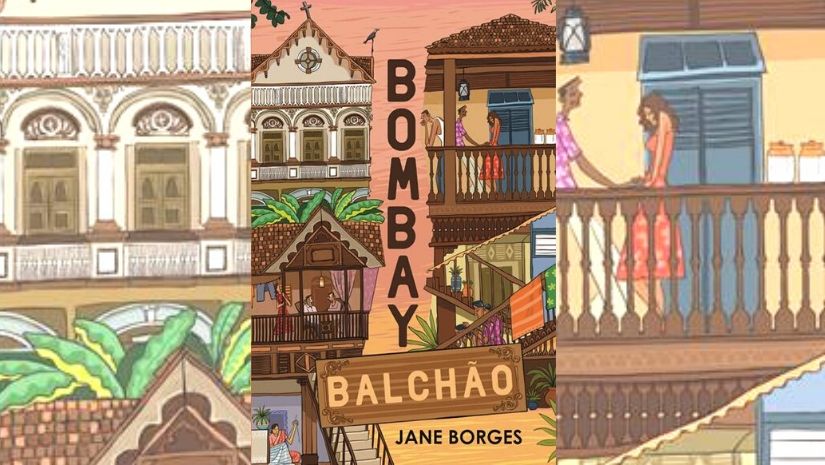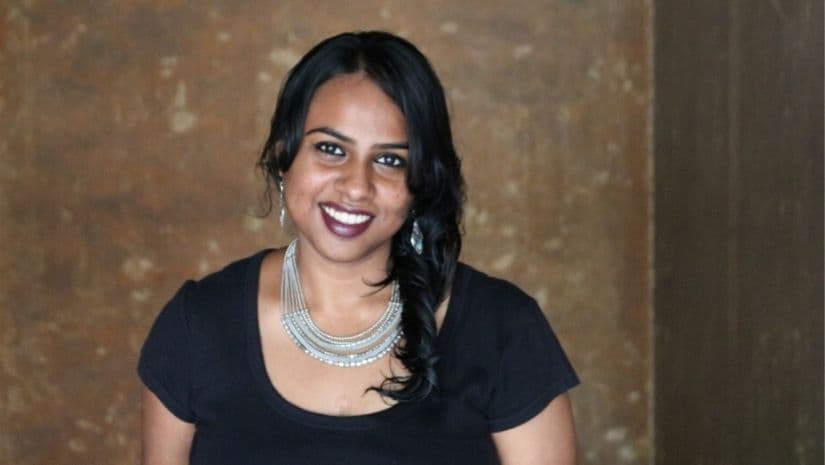Mumbai is a city with many stories to tell; every nook and cranny is brimming with characters, remarks author and journalist Jane Borges, who provides a slice-of-life glimpse of the city’s Goan, Mangalorean and East Indian residents in her latest work, Bombay Balchão. She writes a fictional tale of the families from Cavel, a small Catholic neighbourhood in South Mumbai, drawing on her conversations with the people who migrated to the city and formed their community in this area. Mafia Queens of Mumbai, Borges’ previous non-fiction book (co-written with S Hussain Zaidi), features stories of the women from Mumbai’s Underworld, a narrative of true crimes from the city’s streets and back-alleys. Her latest novel however, tells the stories of characters drawn from the idiosyncrasies of people who lived and died in Cavel. The romance and losses of her protagonist Michael Coutinho, his sister Annette, his wife Merlyn, and his friend Ellena, embody seemingly ordinary tales which are in fact teeming with sorrow, longing and desire. While each of the chapters in Bombay Balchão could be a story in itself, together, the author weaves a tale that brings together the lives of all her characters and paints a vivid picture of the locality of Cavel and its inhabitants. In an interview with Firstpost, Borges talks about why she named her book after the Goan balchão, her favourite recipes and why Cavel formed the setting for her story. Edited excerpts: Could you tell us a little bit about the title of the book and why you decided to name your work after the spicy Goan pickle? The story behind the name Bombay Balchão is quite interesting, actually. Sometime last year, when pitching the manuscript to publishers, my literary agent, Anish Chandy (of Labyrinth Literary Agency), had asked me to come up with a tentative title for the book. Until then, I hadn’t even thought about it. After procrastinating for days on end, my brother and I came up with Bombay Balchão. In Goa, the balchão masala is traditionally used to prepare a prawn side dish that has a pickle-like flavour to it. Additionally, it can be used as a fish preserve too. This particular pickle is a melting point of flavours: It is spicy, as well as tangy and sweet. Since the novel comprises an assortment of quirky, sweet and hot-headed characters, it fit well with the ethos of this book. We eventually went with it, half convinced. I hadn’t written the last chapter until then. Seven months later, the title led me to that chapter. And suddenly, it all made sense. [caption id=“attachment_7668511” align=“alignnone” width=“825”]  Jane Borges’ Bombay Balchão provides a slice of the lives of the Goan, Mangalorean and East Indian communities inhabiting Cavel, a small neighbourhood in Mumbai.[/caption] Why did you choose Cavel as the setting for your story? As well, growing up, did you spend a lot of time in Mumbai? What were some of your early interpretations of the city and its people? Cavel is a small and quaint Catholic neighbourhood in Marine Lines, Mumbai. Not known to many, it is one of the oldest Latin quarters in South Mumbai. This is where the Portuguese missionaries are said to have settled back in the 16th century. From the work of historian Teresa Albuquerque, I came to learn that the plot where the church in the neighbourhood — Our Lady of Health — stands, once housed the private chapel of a Portuguese gentleman Pedro Jose de Moura. It was later opened to the native Christians, converted by these missionaries, and who today call themselves East Indians. By the turn of 19th century, the Goans migrated to the port city for better opportunities, settling down in Christian pockets like Cavel. That’s how this neighbourhood has more Goans than East Indians. Cavel also has a rich legacy. St Xavier’s High School, Dhobi Talao, which turned 150 in January this year, initially ran out of Cavel. Famed Mumbai historian Olga Valladares, who passed away recently, lived here. Nineteenth century Goan historian and physician José Gerson da Cunha (1844-1900) is also said to have resided here. The neighbourhood has even given the city three mayors – Dr Joseph Collaco, Dr Joseph Alban D’Souza and Dr Joseph Leon D’Souza. The history of this place is hence very closely tied to the city. Unfortunately, it has all been forgotten. My tryst with Cavel began when my family moved here in 2003. Initially, I did not think much of it. But after living here, engaging with the community, listening to their stories and being part of their festivities, I realised it also had a rich culture. There are several other Christian neighbourhoods in the vicinity of Cavel – Dhobi Talao, Sonapur, Dabul and Khotachi Wadi – whose histories are inter-connected in a similar way. But we are actually a forgotten lot, and most importantly, fast disappearing. Many residents from these areas have migrated abroad, or moved to the suburbs. Today, we are just a handful. I felt there was a need to preserve their stories. It’s not like historians have not done that in the past. But sometimes, fiction can do what facts can’t, which is to evoke an emotional reaction. You have interacted with several locals while researching for Bombay Balchão. How did these people influence the characters and the plot of your narrative? It just so happened that I spent a lot of time with my old neighbours and even became great friends with some of them. They were brilliant raconteurs. Eventually, when writing this book, snatches from these conversations, helped me further my plot. For instance, my late neighbour Lulu Days mentioned that her brother-in-law, Arnold Days, a firefighter, died in the 1944 Bombay Port explosion. Arnold inspired David Lawrence, a character in my book. Former veteran journalist Ervell E Menezes, a very dear friend, had shared an incident once, of how he was forced to grow a beard as a decoy to keep away a bunch of goons, who he had written about. He wore that beard till he passed away last year. My protagonist, Michael Coutinho, wears a beard for a similar reason. In 2016, I had done a feature story on crossword enthusiast Joe Albuquerque, a resident of Dabul, which is a stone’s throw from Cavel, for the newspaper where I work. A character called Mario in the novel, shares a similar passion for the game. None of the events in the book really happened, but conversations with the residents helped me place my characters in a world that was close to real. [caption id=“attachment_7668501” align=“alignnone” width=“825”]  Journalist and author Jane Borges has previously co-written Mafia Queens of Mumbai with S. Hussain Zaidi.[/caption] As the blurb for the book reads, these are ordinary stories that become legends when perceived through the eyes of the characters. How did reconcile your conversations with the locals with your idea for the stories and conflicts of your characters and their relationships with one another? From conversations with the residents, I picked up certain traits that are very Cavel. Often one’s personality is also shaped and influenced by the place they have been raised in. If there was a conflict situation in the book, I would first think of how a Cavelite would react or respond, and then accordingly, take the story forward. But that is just my observations and observations can be subjective. How was your experience of writing this work different from the research and writing involved in Mafia Queens of Mumbai? Oh, very, very different. MQM was hard-core crime non-fiction. It required extensive research. You couldn’t tamper with facts. This one was a community story. There is no bloodshed and killing (thank god for that). The exercise of writing this novel actually began because I was missing home. I had briefly moved to Muscat between 2013 and 2015, and got homesick. The stories, initially meant to be short stories, helped me tide through that feeling. When I returned to Mumbai, I abandoned the project altogether. It was only last year that I picked it up again. Incidentally, it was my commissioning editor, Sanghamitra Biswas, who suggested that I look at the history of Cavel more seriously. In your book, the balchão almost becomes a character in the story. Could you elaborate on why you chose to fill your book with such a mouth-watering food and feasts galore? Food is such an important part of the East Indian, Goan and Mangalorean celebrations in Mumbai. It’s not as much a character, but a way of life. If there is feasting — and there are so many such occasions in the book — food has to be there. I couldn’t ignore it. So, you come across bangda fry with recheado masala, bhindi aani sungta chi kuddy (prawn and okra curry), pork chops, mutton cutlets etc. Balchão just happened to get special status, because there was an entire chapter dedicated to it. Among all these delicious Goan recipes, which one is your favourite and what do you associate it with? Does it appear in the book as well? I am actually from Karwar in Karnataka, which shares its border with Goa. My mum is Mangalorean. But my dad’s mother is Goan. So, in our home we cook food from these three regions. Having said that, I really love the bangda fry with recheado masala. I have written about it in the book. And, my mum makes it well. She kind of combines the Mangalorean and Goan masalas, and that’s why it really stands out. Listen to Jane Borges read this excerpt from her novel, Bombay Balchão (Chapter 1: Paper Hearts, December 2015) —
Mumbai is a city with many stories to tell; every nook and cranny is brimming with characters, remarks author and journalist Jane Borges, who provides a slice of the city’s Goan, Mangalorean and East Indian residents in her latest work, Bombay Balchão.
Advertisement
End of Article


)
)
)
)
)
)
)
)
)



